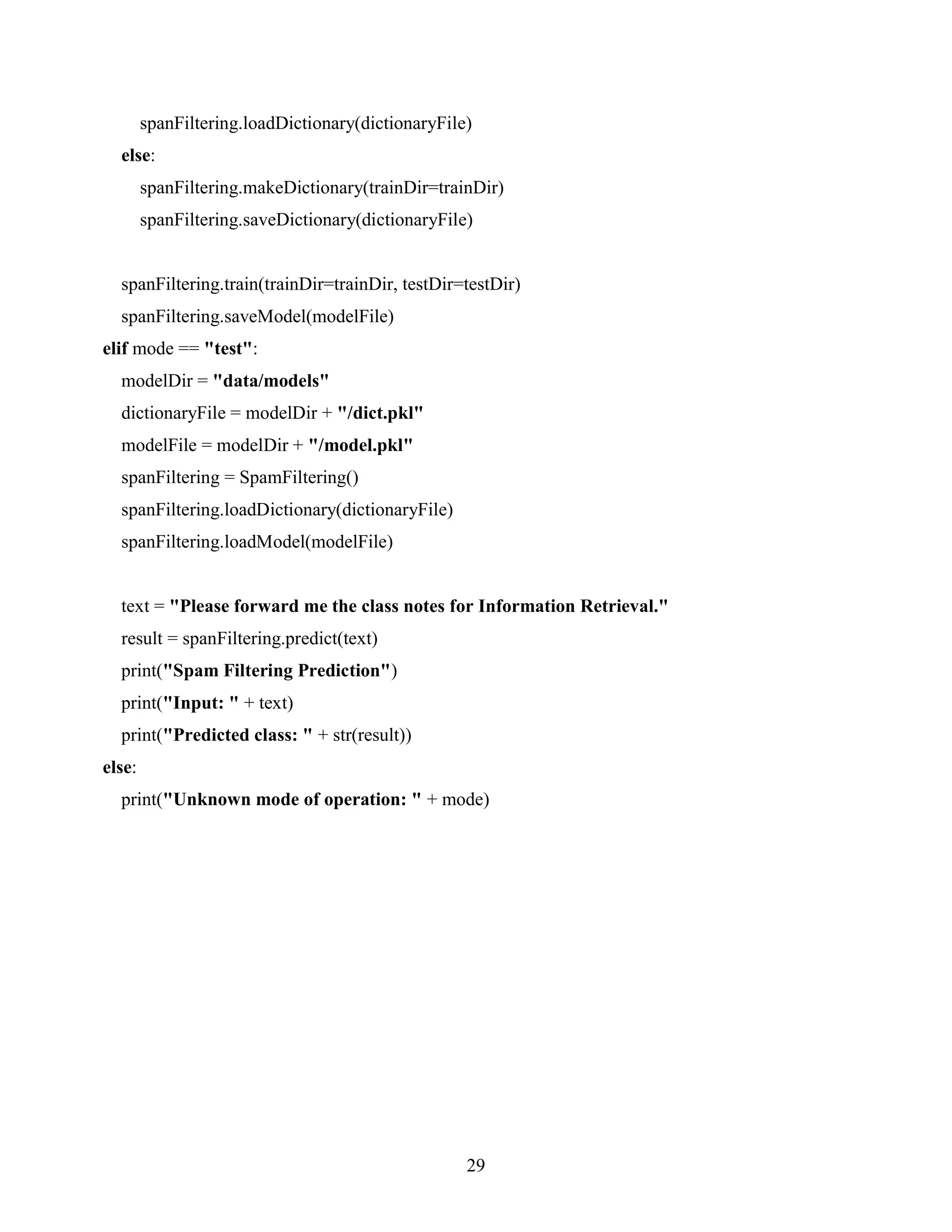The document presents a final year project on spam email identification conducted by students at the Asian School of Management and Technology, under the supervision of Mr. Bikash Balami. It details the issue of electronic spamming, specifically email spam, and discusses a Bayesian approach for spam detection, emphasizing the need for effective filtering methods. The project includes sections on requirements analysis, system design, implementation, and experimental results, aiming to efficiently classify emails as spam or non-spam.
![Asian School of Management and Technology
Affiliated to Tribhuvan University
Gongabu, Kathmandu.
A Final Year Project
On
Spam E-mail Identification
[CSC-404]
Under the supervision of
Mr. Bikash Balami
Department of Computer Science
Asian School of Management and Technology
Submitted By:
Nabin Jamkatel (3391)
Rajiv Gupta (3396)
Rakesh Chhetri (3397)
Sabina Lamichhanne (3398)
Submitted To:
Department of Computer Science and Information
IOST, TU](https://image.slidesharecdn.com/spamemailidentification-180125111604/75/Spam-Email-identification-1-2048.jpg)
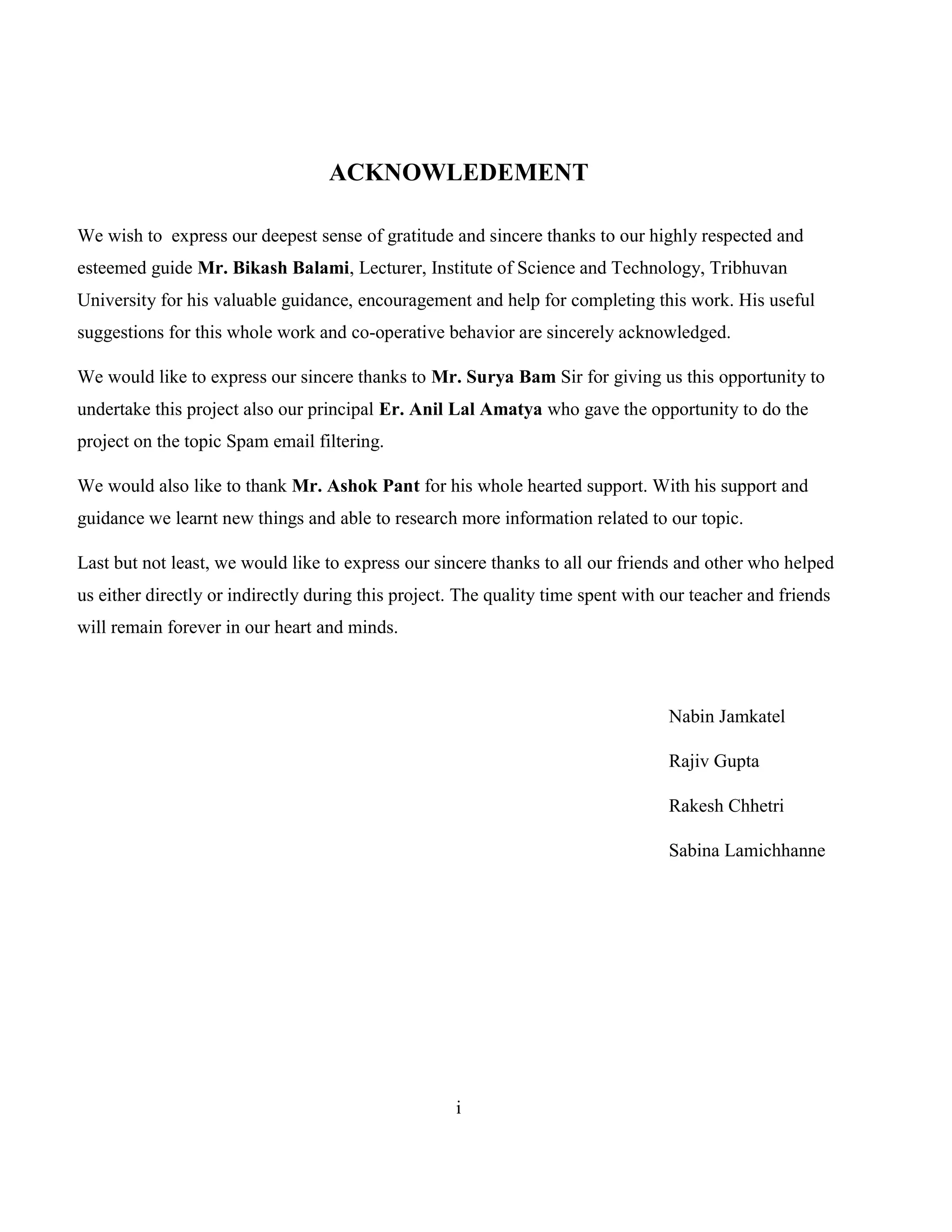
![ii
ABSTRACT
Electronic spamming is the use of electronic messaging systems to send an unsolicited message
(spam), especially advertising, as well as sending messages repeatedly on the same site. While the
most widely recognized form of spam is email spam, the term is applied to similar abuses in other
media: instant messaging spam, Usenet newsgroup spam, Web search engine spam, spam in blogs,
wiki spam, online classified ads spam, mobile phone messaging spam, Internet forum spam, junk
fax transmissions, social spam, spam mobile apps, television advertising and file sharing
spam,[6].
The source and identity of the sender is anonymous and there is no option to cease receiving
future e-mails. Span e-mail is usually sent by spam bot, which is program that continually sends
out email. Often spammers will create a virus that install a spam bot into unsuspecting users
computers and will use there internet connection and computer to send spam.
Spam e-mail are message randomly sent to multiple addressees by all sorts of groups, but mostly
lazy advertisers and criminals who wish to lead you to phishing sites. The sites attempt to steal your
personal, electronic, and financial information.
Bayesian Spam Detection/ Filtering is used to detect spam in an email. A Bayesian network is a
representation of probabilistic relationships. This paper will show that Bayesian filtering can be
simply implemented for a reasonably accurate text classifier and that it can be modified to make a
significant impact on the accuracy of the filter.](https://image.slidesharecdn.com/spamemailidentification-180125111604/75/Spam-Email-identification-3-2048.jpg)
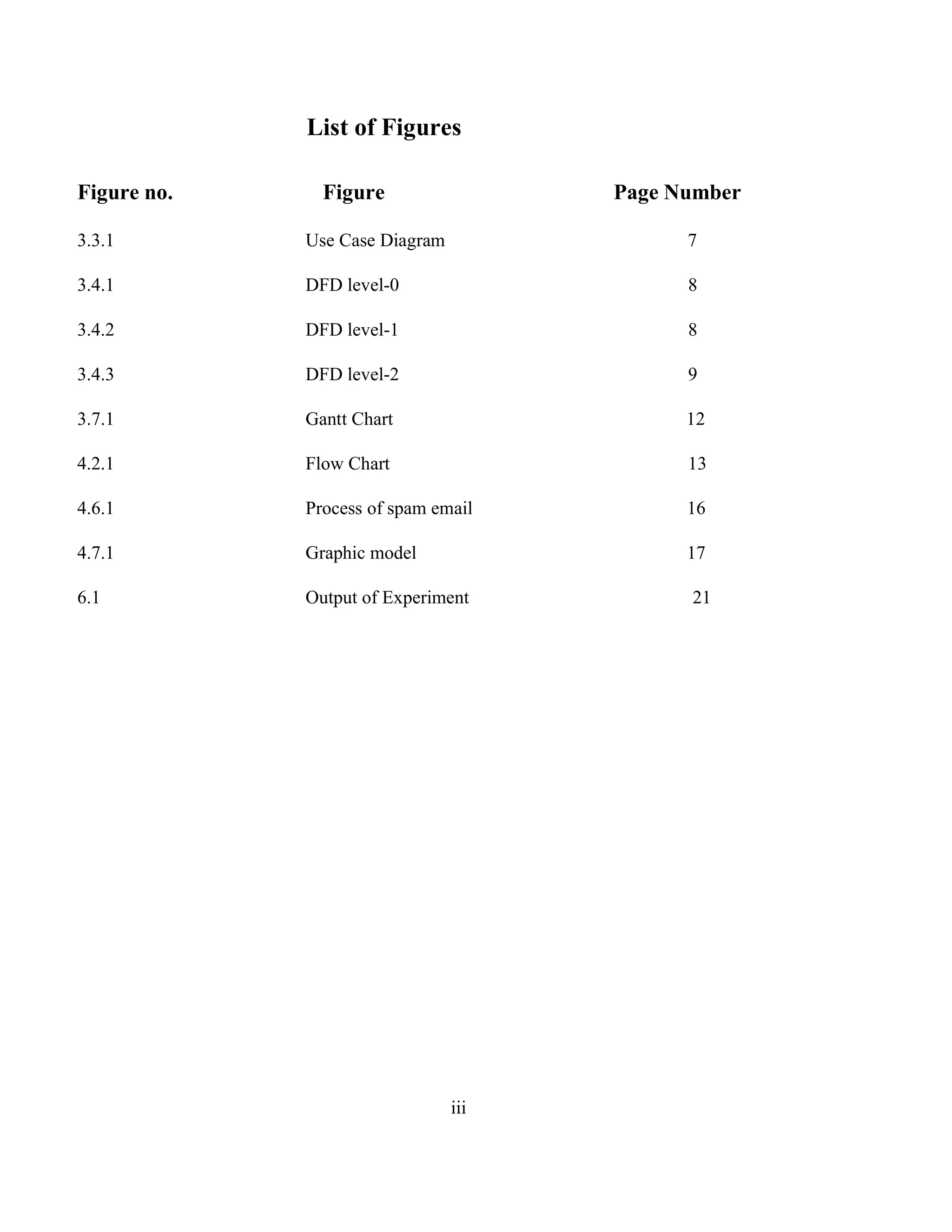
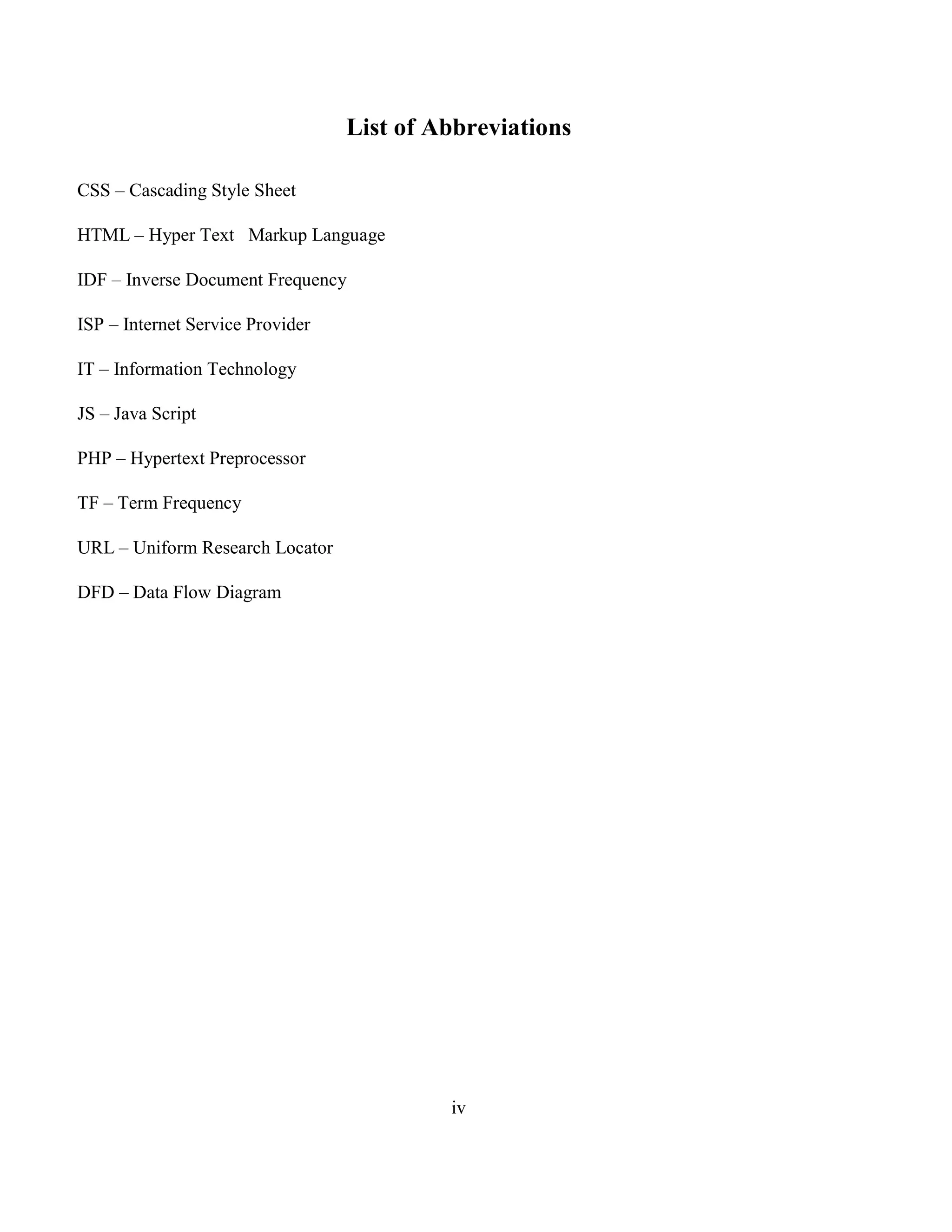

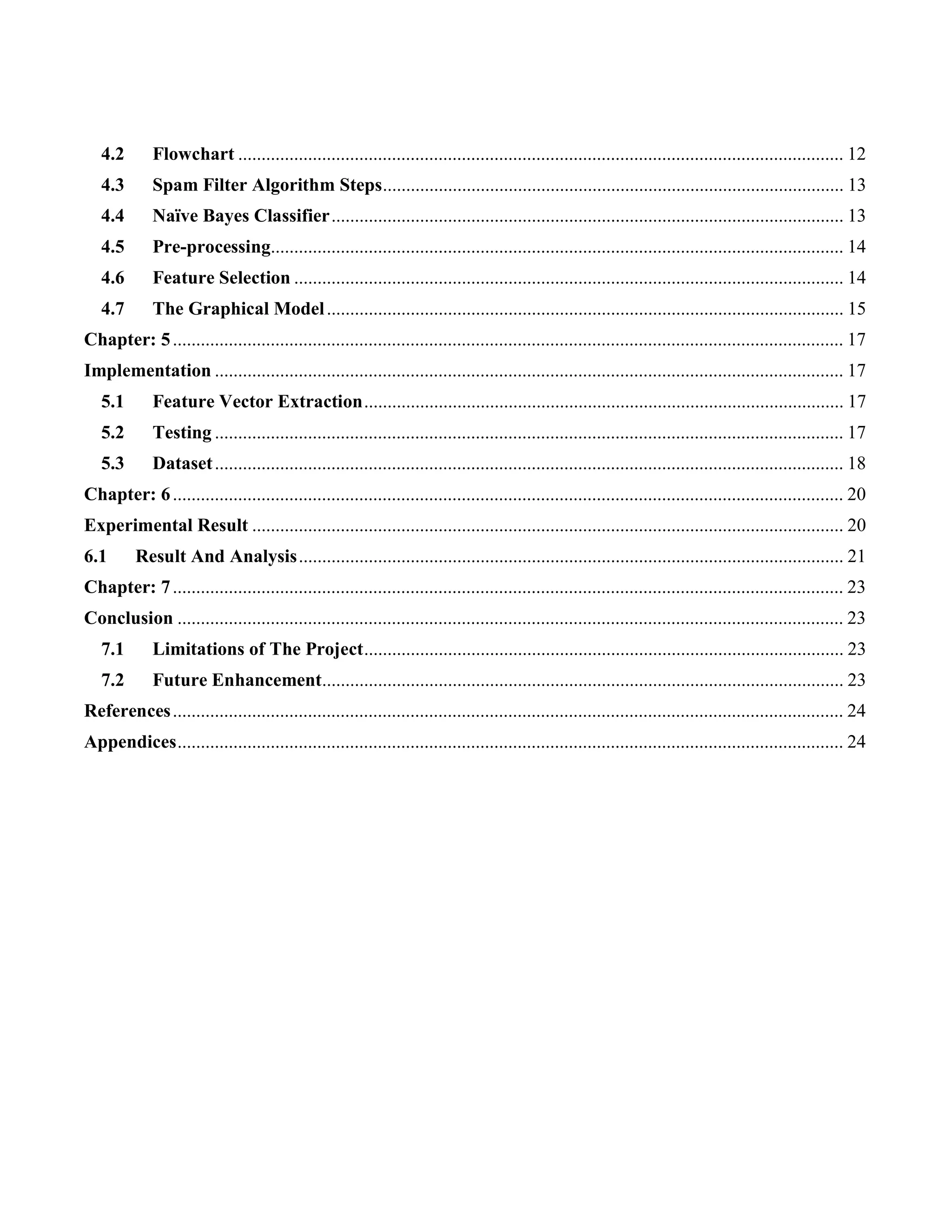
![1
Chapter: 1
Introduction
1.1 Background
Major approaches adopted towards spam filtering include text analysis, white and black lists of domain
names and community based approaches. Text analysis of contents of mails is a widely used approach
towards the spams. Many solutions deployable on server and client sides are available. Naive Bayes is
one of the most popular algorithms used in these approaches. Spam Bayes and Mozilla Mail spam filter
are examples of such solutions. But rejecting mails based on text analysis can be serious problem in case
of false positives. Normally users and organizations would not want any genuine e-mails to be lost. Black
list approach has been one of the earliest approaches tried for the filtering of spams. The strategy is to
accept all the mails except the ones from the domain/e-mail ids. Explicitly blacklisted. With newer
domains entering the category of spamming domains this strategy tends to not work so well. White list
approach is the strategy of accepting the mails from the domains/addresses explicitly white listed and put
others in a less priority queue, which is delivered only after sender responds to a confirmation request sent
by the spam filtering system.
1.2 Problem Statement
Spamming is one of the major attacks that accumulate the large number of compromised machines by
sending unwanted messages, viruses and phishing through emails. We have chosen this project because
now days there are lot of people trying to fool you just by sending you fake e-mails like you have won
1000 dollars, this much amount is deposited in your account once you open this link then they will track
you and try to hack your information. Sometimes relevant e-mails are considered as spam emails[4].
• Unwanted email irritating Internet consumers.
• Critical email messages are missed and/or delayed.
• Consumers change ISP's all the time looking for consistent email delivery.
• Loss of Internet performance and bandwidth.](https://image.slidesharecdn.com/spamemailidentification-180125111604/75/Spam-Email-identification-8-2048.jpg)

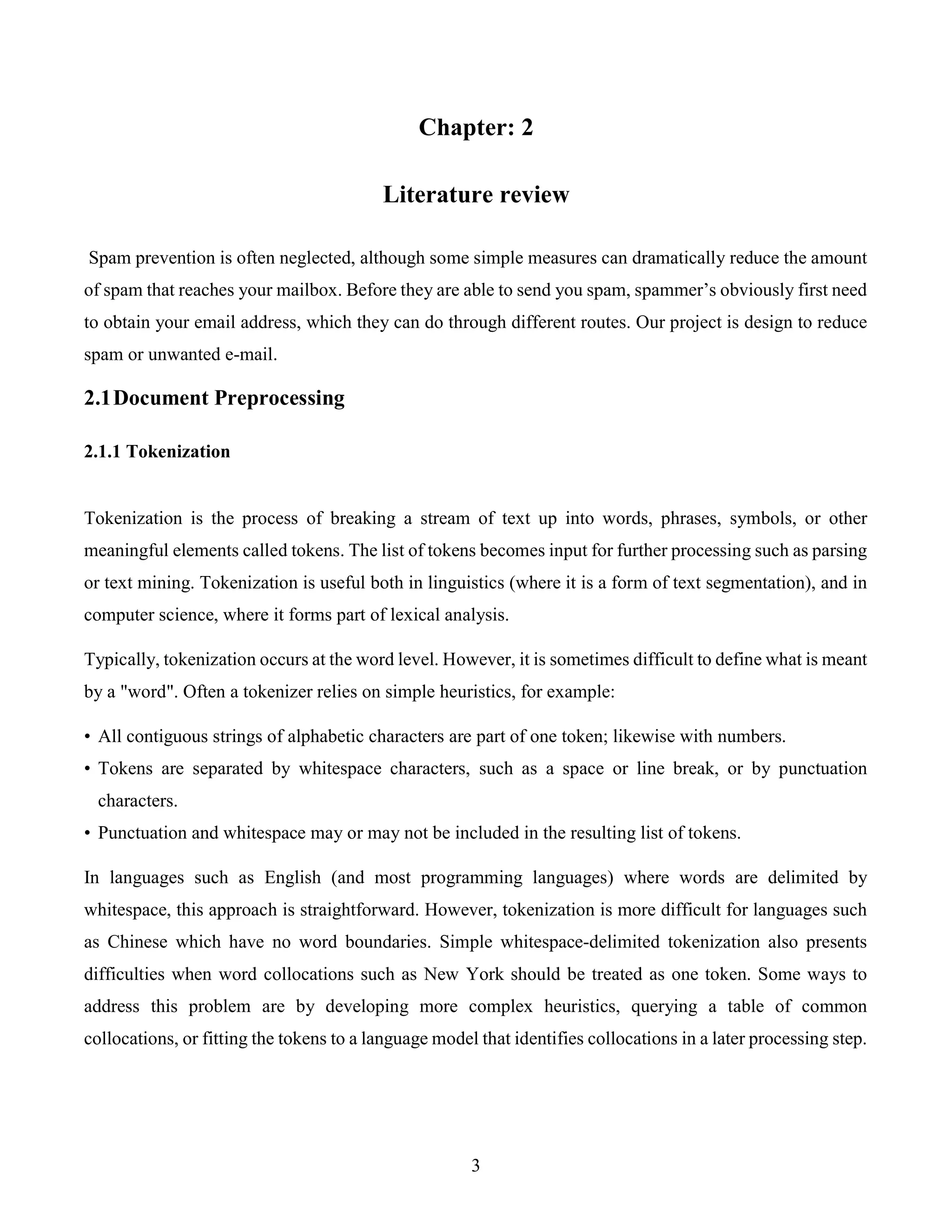
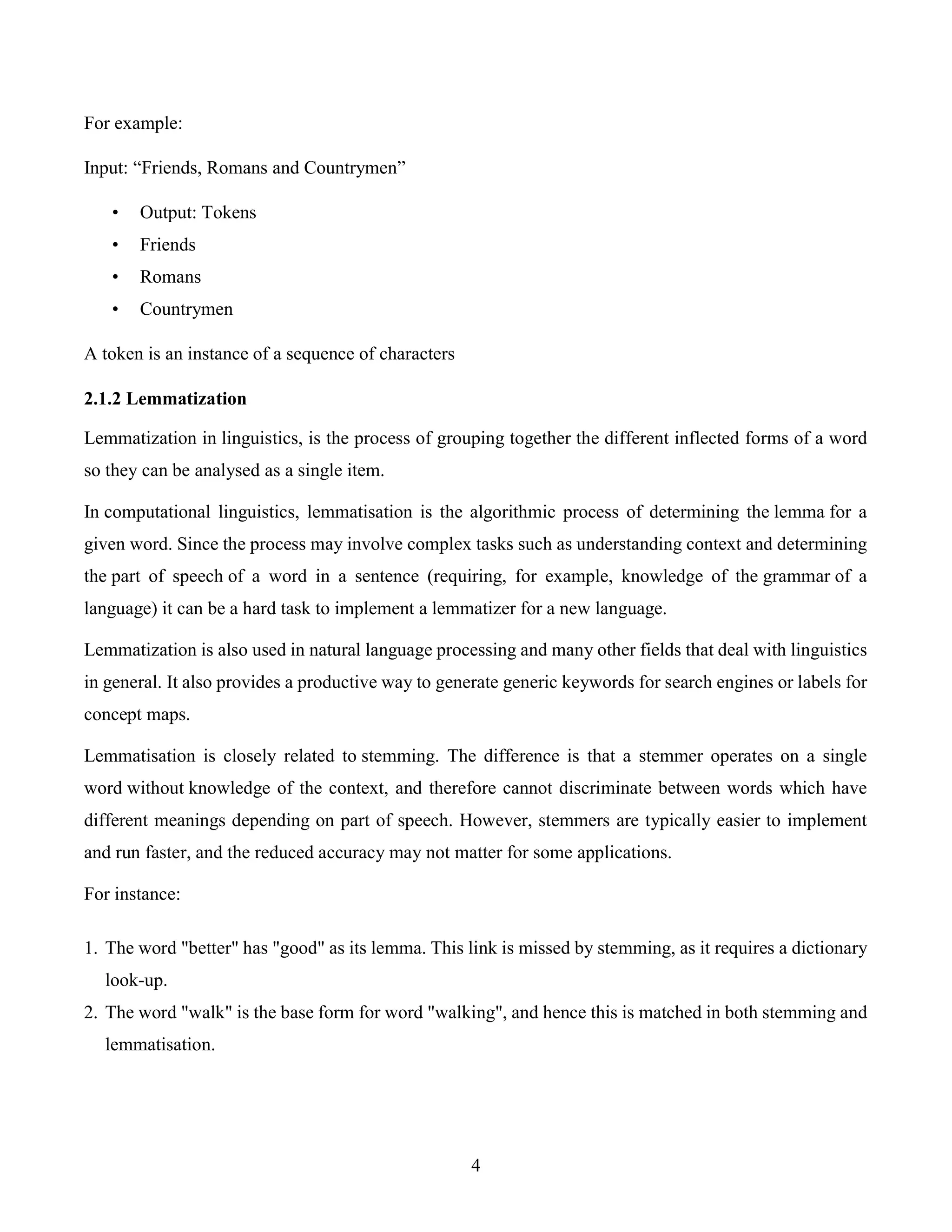
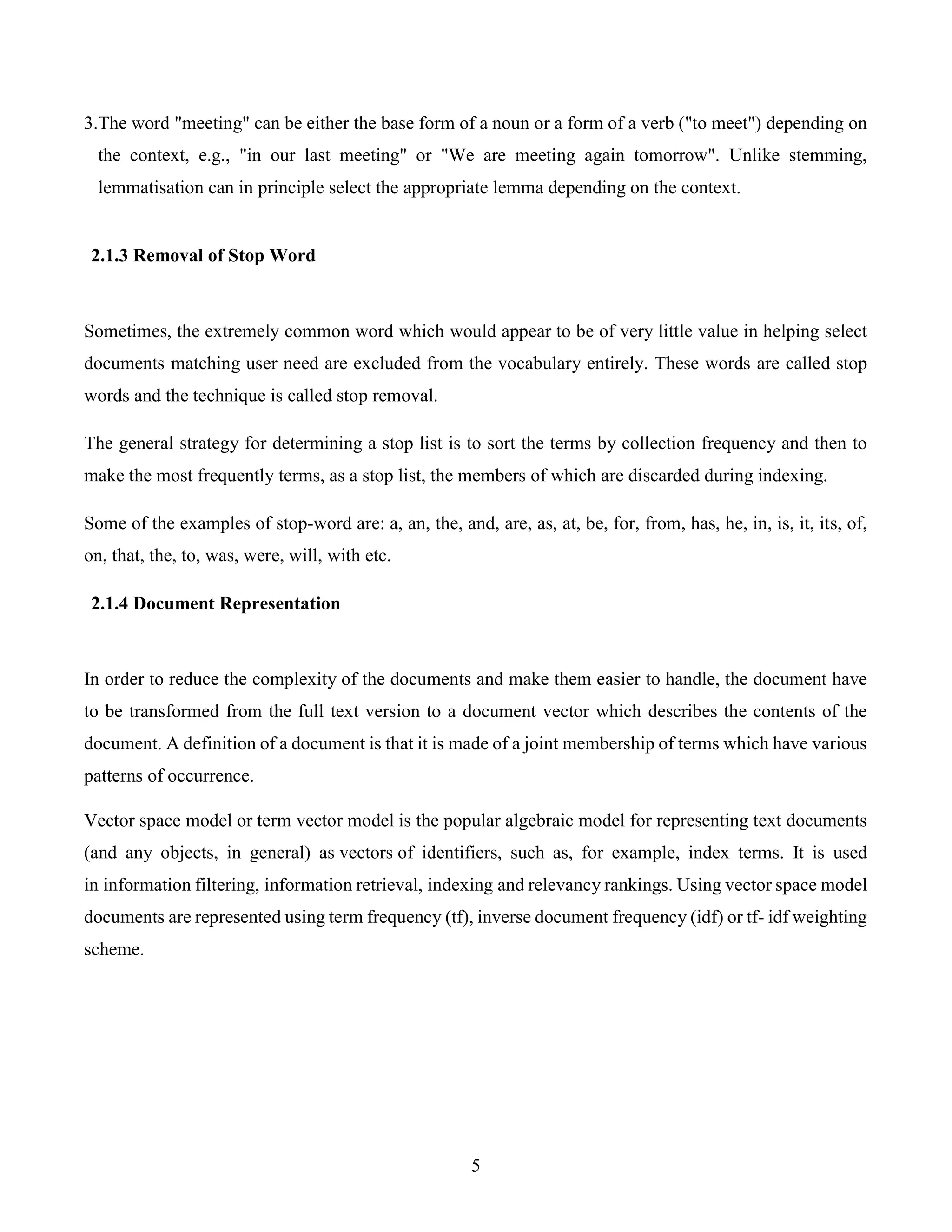


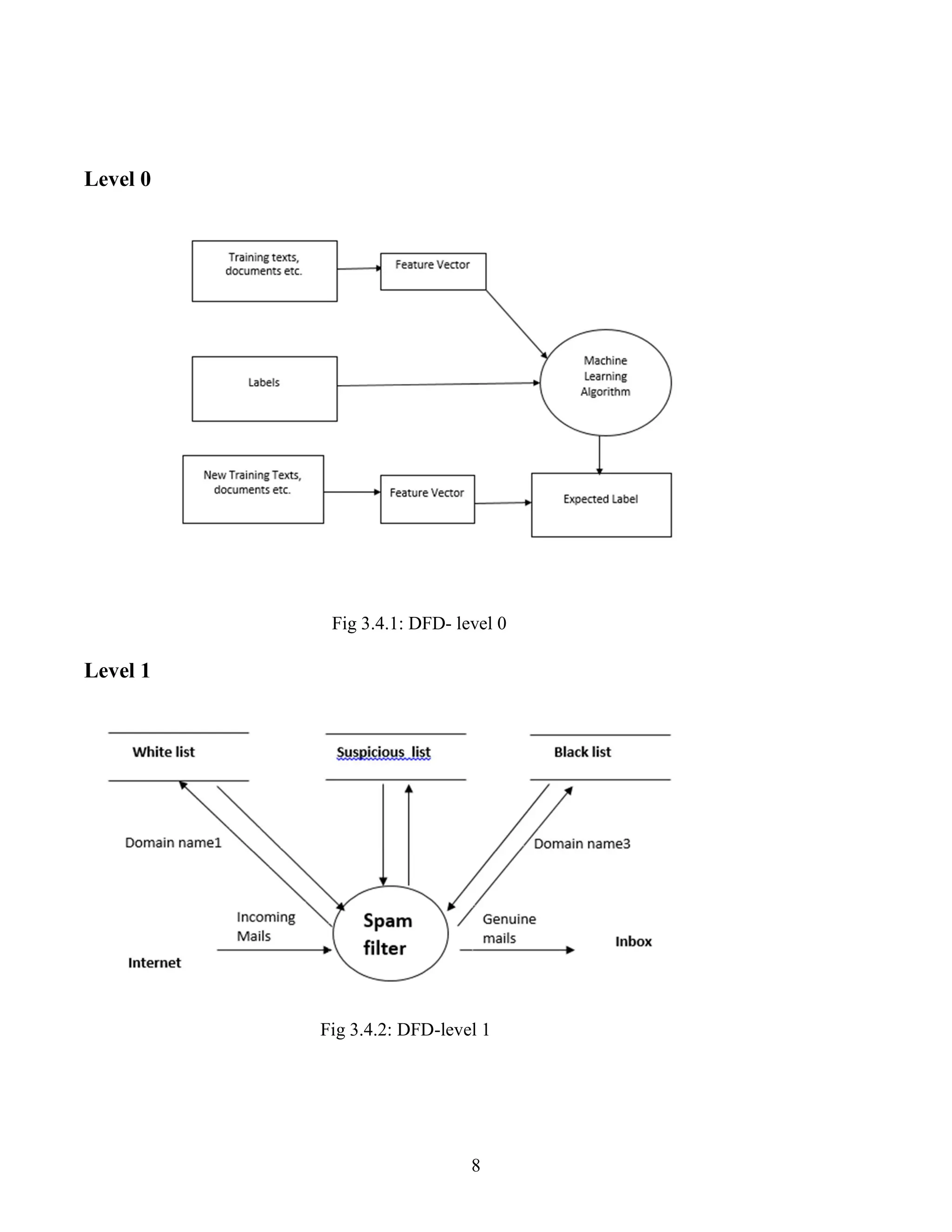
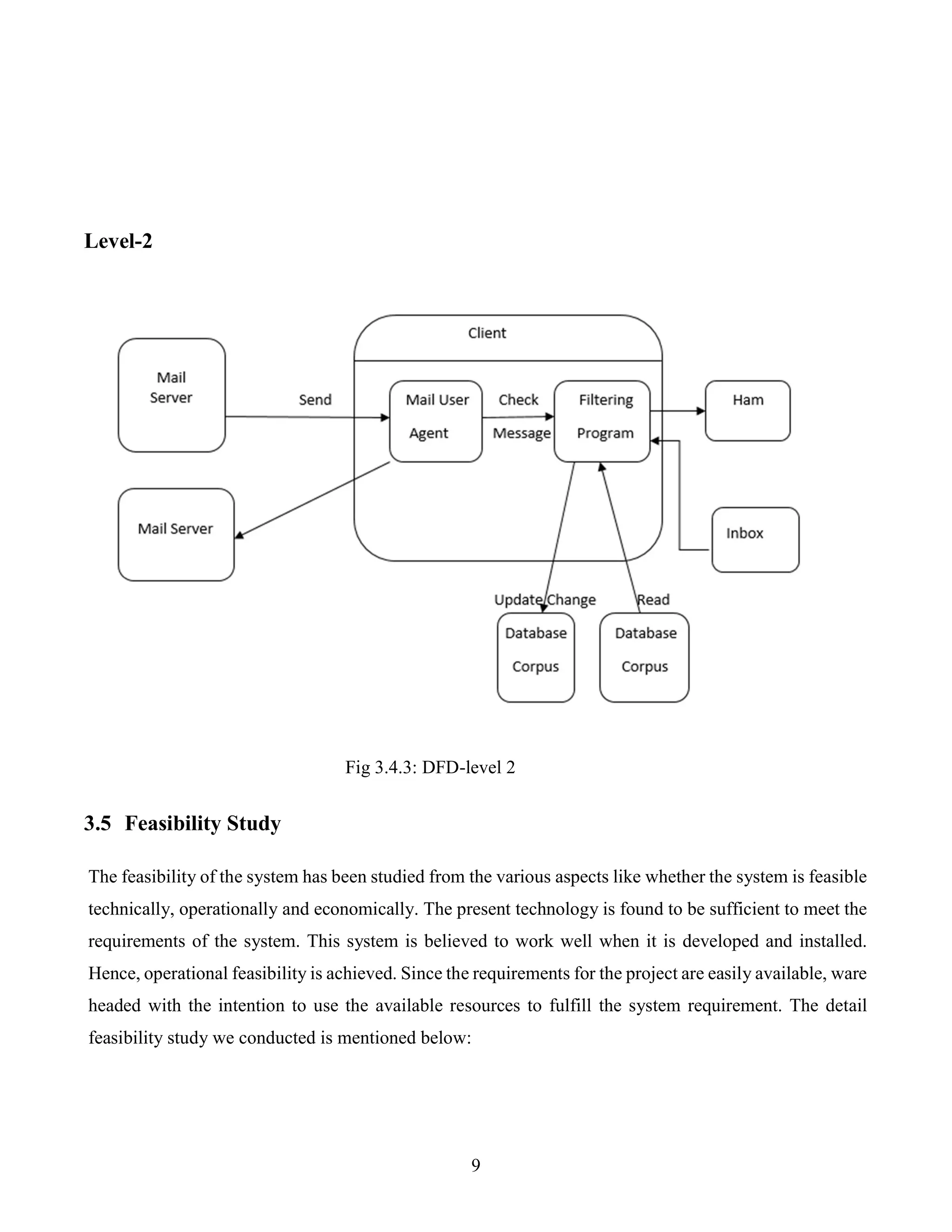
![10
3.6.1 Technical Feasibility
The technology needed for the proposed system that we are going to develop is available. We can work
for the project is done with current equipment existing tools like python .We can develop our system still
using this technology if needed to upgrade. In future, if we want to use new technology like android app
of our system it is possible. Hence, the system that we are going to develop will successfully satisfy the
needs of the system for technical feasibility
3.6.2 Economic Feasibility
Since the system is developed as a part of project work, there is no manual cost to spend for the proposed
system. Also all the resources are already available, it gives an indication that the system is economically
possible for development. Economic justification is generally the "Bottom Line" consideration for most
systems. The cost to conduct a full system investigation is negotiable because required information is
collected from internet.We can run our system in our normal hardware like desktop, laptop mobiles and
so on. This system won't require extra specific software to use it. Hence, the project that we are going to
develop won't require enormous amount of Money to be developed so it will be economically feasible.
3.6.3 Operational Feasibility
The user interface will be user friendly and no training will be required to use the application. The solution
proposed for our project is operationally workable and most likely convenient to solve the irrelevant
document and fraud e-mail [2].](https://image.slidesharecdn.com/spamemailidentification-180125111604/75/Spam-Email-identification-17-2048.jpg)

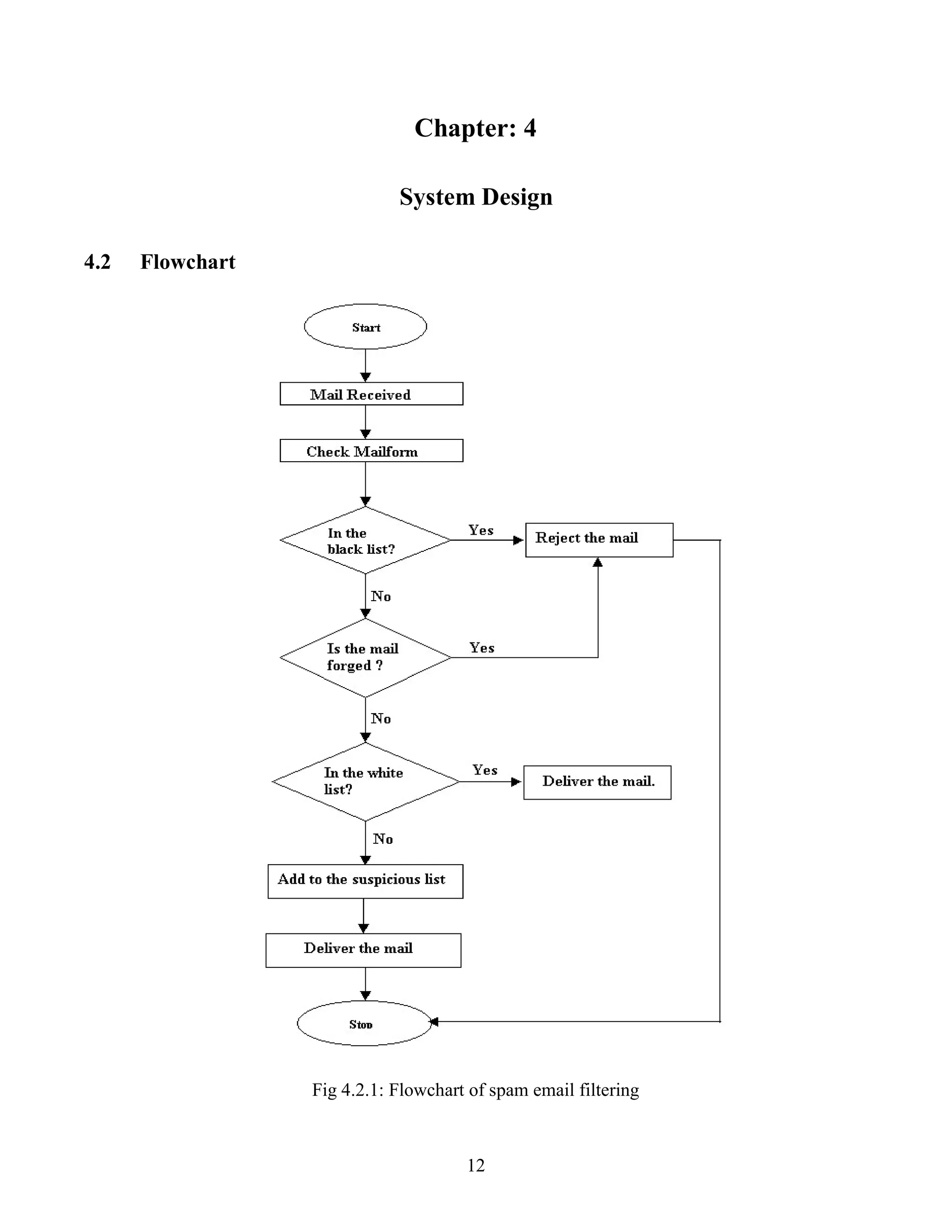
![13
4.3 Spam Filter Algorithm Steps
Handle Data: Load the corpus file and split it into training and test datasets.
Summarize Data: summarize the properties in the training dataset so that we can calculate
probabilities and make predictions.
Make a Prediction: Use the summaries of the dataset to generate a single prediction.
Make Predictions: Generate predictions given a test dataset and a summarized training dataset.
Evaluate Accuracy: Evaluate the accuracy of predictions made for a test dataset as the percentage
correct out of all predictions made.
Tie it together: Use all of the code elements to present a complete and standalone implementation of
the Naive Bayes algorithm.
4.4 Naïve Bayes Classifier
The Naive Bayes algorithm is a simple probabilistic classifier that calculates a set of probabilities by
counting the frequency and combination of values in a given dataset [4]. In this research, Naive Bayes
classifier use bag of words features to identify spam e-mail and a text is representing as the bag of its
word. The bag of words is always used in methods of document classification, where the frequency of
occurrence of each word is used as a feature for training classifier. This bag of words features are included
in the chosen datasets.
Naive Bayes technique used Bayes theorem to determine that probabilities spam e-mail. Some words have
particular probabilities of occurring in spam e-mail or non-spam e-mail. Example, suppose that we know
exactly, that the word Free could never occur in a non-spam e-mail. Then, when we saw a message
containing this word, we could tell for sure that were spam email. Bayesian spam filters have learned a
very high spam probability for the words such as Free and Viagra, but a very low spam probability for
words seen in non-spam e-mail, such as the names of friend and family member. So, to calculate the
probability that e-mail is spam or non-spam Naive Bayes technique used Bayes theorem as shown in
formula below.](https://image.slidesharecdn.com/spamemailidentification-180125111604/75/Spam-Email-identification-20-2048.jpg)
![14
Where:
(i) P(spamword) is probability that an e-mail has particular word given the e-mail is spam.
(ii) P(spam) is probability that any given message is spam.
(iii)P(wordspam) is probability that the particular word appears in spam message.
(iv)P(non − spam) is the probability that any particular word is not spam.
(v) P(wordnon − spam) is the probability that the particular word appears in non-spam message.
To achieve the objective, the research and procedure is conducted in three phases. The phases involved
are as follows:
1. Phase 1: Pre-processing
2. Phase 2: Feature Selection
3. Phase 3: Naive Bayes Classifier
The following sections will explain the activities that involve in each phases in order to develop this
project. Figure 2 shows the process for e-mail spam filtering based on Naive Bayes algorithm.
4.5 Pre-processing
Today, most of the data in the real world are incomplete containing aggregate, noisy and missing values.
Pre-processing of e-mails in next step of training filter, some words like conjunction words, articles are
removed from email body because those words are not useful in classification[i]
.
4.6 Feature Selection
After the pre-processing step, we apply the feature selection algorithm, the algorithm which deploy here
is Best First Feature Selection algorithm.](https://image.slidesharecdn.com/spamemailidentification-180125111604/75/Spam-Email-identification-21-2048.jpg)

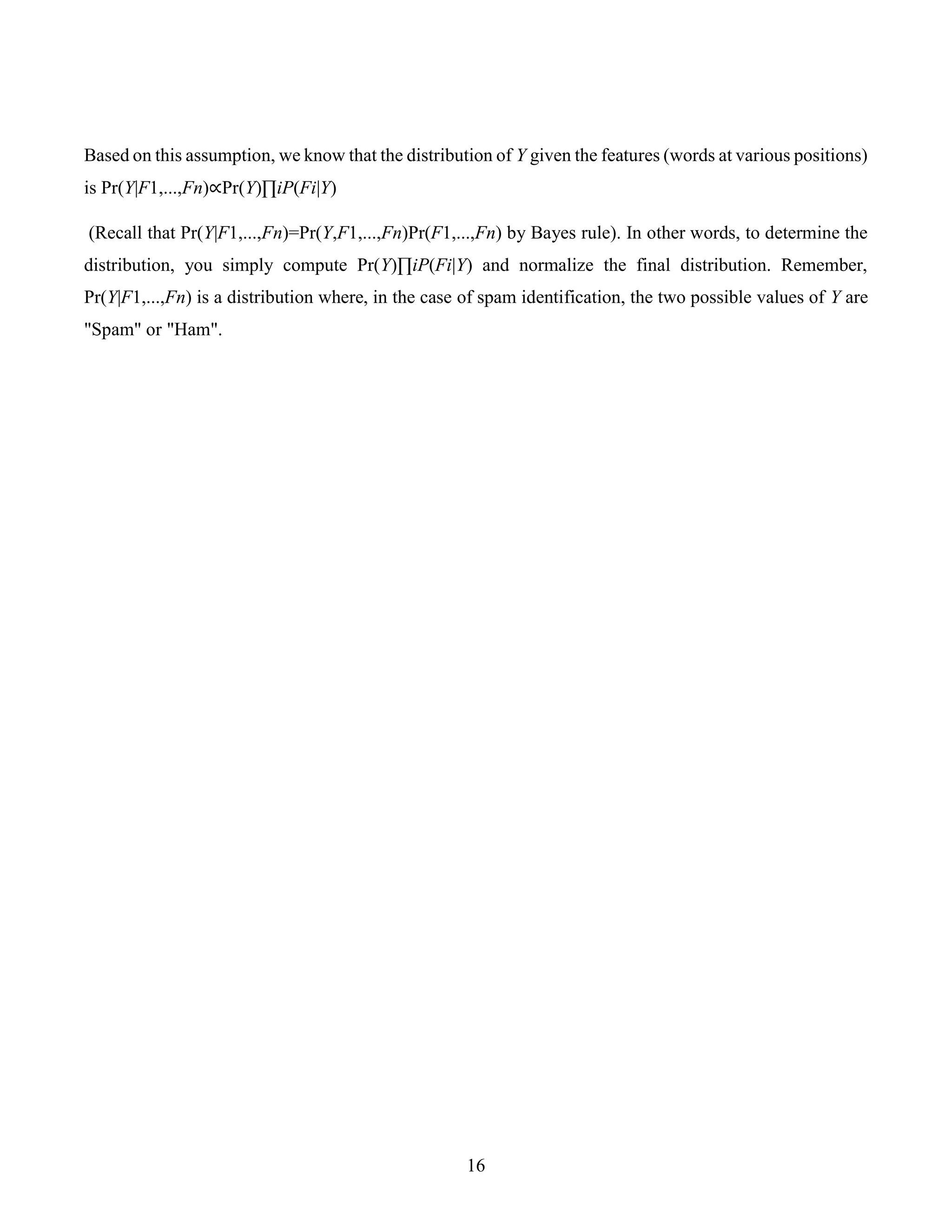
![17
Chapter: 5
Implementation
5.1 Feature Vector Extraction
We have calculated the Feature Vector by using a dictionary and extracted the probabilities of word that
appear to be spam or non-spam. The code below shows the extraction of feature vector extraction
def createFeautes(self, text):
words = text.split()
feature = np.zeros(len(self.dict))
for word in words:
try: /// Handling exception in feature vector exception
d = list(self.dict.keys()).index(word)
feature[d] = 1
except Exception as e:
pass
return feature
5.2Testing
In order to create algorithm for this, we need to teach our program what a spam email looks like and what
non-spam emails look like. . We also need a way to test the accuracy of our spam filter. One idea would
be to test it on the same data that we used for training. However, this can lead to a major problem in ML
called overfitting which means that our model is too biased towards the training data and may not work as
well on elements outside of that training set. One common way to avoid this is to split our labeled data for
training/testing. This ensures we test on different data than we trained on. It’s important to note that we
need a mix of both spam and non-spam data in our data sets, not just the spam ones. We really want our
training data to be as similar to real email data as possible. The sample data for training of non-spam data
is shown as below:](https://image.slidesharecdn.com/spamemailidentification-180125111604/75/Spam-Email-identification-24-2048.jpg)
![18
5.3Dataset
Dataset is a collection of data or related information that is composed for separate elements. A collection
of dataset for e-mail spam contains spam and non-spam messages. In this research, two datasets are be
used to evaluate the performance of Naive Bayes algorithm to filter e-mail spam.
Dataset 1: Spam Data
Spam Data is used in order to test the performance of spam filter based on Naive Bayes algorithm [7]
.
Subject: re :
2 . 882 s - > np np> deat : sun , 15 dec 91 2 : 25 : 2 est > : michael < mmorse @ vm1 . yorku . ca > >
subject : re : 2 . 864 query > > wlodek zadrozny ask " anything interest " > construction " s > np np " . . .
second , > much relate : consider construction form > discuss list late reduplication ? > logical sense " john
mcnamara name " tautologous thus , > level , indistinguishable " , , here ?" . ' john mcnamara name '
tautologous support those logic-base semantics irrelevant natural language . sense tautologous ? supplies
value attribute follow attribute value . fact value name-attribute relevant entity ' chaim shmendrik ' , ' john
mcnamara name ' false . tautology , . ( reduplication , either . )
The sample data for testing of non-spam data
Subject: book : phonetic / speech production
shigeru kiritanus , hajime hirose hiroya fujisakus ( editor ) speech production language honor osamu
fujimura 1997 . 23 x 15 , 5 cm . x , 302
page . cloth dm 188 , - / approx . us $ 134 . 0 isbn 3-11 - 6847 - 0 speech research 13 mouton de gruyter
* berlin * york osamu fujimura renown interest competence wide variety subject rang physics,
physiology phonetics linguistics artificial intelligence . through fusion discipline show us human
speech language relate physical physiological process phonetics abstract , higher-level linguistic
structure. reflect osama fujimura 's long-stand interest , chapter volume provide wide perspective
various aspect speech production ( physical , physiological , syntactic , information theoretic )
relationship structure speech language . content 1 background * manfr r . schroeder , speech : physicist](https://image.slidesharecdn.com/spamemailidentification-180125111604/75/Spam-Email-identification-25-2048.jpg)



![22
Dictionary size: 3000
Train samples: Spam=100, Non-Spam=750, Total=850
Test samples: Spam=92, Non-Spam=214, Total=306
labels[ 0 = spam, 1 = non-spam]
Training Evaluation
Accuracy: 99.18%
F1 score: 99.53%
Recall: 99.07%
Precision: 100.00%
Test Evaluation
Classified result: Spam=33, Non- Spam= 274
Recall: (33) / (33+ 60) = 35.55 %
Accuracy: (214+33) / (32+ 60 +6 + 214) = 247/ 306 = 80.72%
F1 score: (2*78.39* 35.5 )/(78.39+ 35.5)= 50%
Precision: 33/ (33+6) = 33/ 39 = 84.61%](https://image.slidesharecdn.com/spamemailidentification-180125111604/75/Spam-Email-identification-29-2048.jpg)

![24
References
[1]Clemmer, A. (2012). How Bayesian algorithm works. [online] Available at:
https://www.quora.com/How-do-Bayesian-algorithms-work-for-the-identification-of-spam [Accessed 16
Aug. 2017].
[2]Mehetha, A., Jain, A., Dubey, K. and bhisee, M. (2009). Spam Filterer [online]
https://www.slideshare.net/MaitreyeeBhise/spam-filter-51951717. Available at:
https://www.slideshare.net/MaitreyeeBhise/spam-filter-51951717 [Accessed 19 Aug. 2017].
[3]What is Email Spam?. (2017). [Blog] comm100. Available at:
https://emailmarketing.comm100.com/email-marketing-ebook/email-spam.aspx [Accessed 27 Aug.
2017].
[4]G. He, Spam Detection, 1st ed. 2007.
[5]sharma, a. and jain, D. (2014). A survey on spam detection.
[6] En.wikipedia.org. (2017). Spamming. [online] Available at: https://en.wikipedia.org/wiki/Spamming
[Accessed 29 Aug. 2017].
[7] bot2, V. (2017). Email Spam Filtering : A python implementation with scikit-learn. [online] Machine
Learning in Action. Available at: https://appliedmachinelearning.wordpress.com/2017/01/23/email-
spam-filter-python-scikit-learn/ [Accessed 30 Aug. 2017].
Appendices
First we import some of the necessary files that we need which is shown by following code
import os
from collections import Counter // Sets the counter
from six.moves import cPickle as pickle
import numpy as np // Imports numpy code for support
from src import naive
class SpamFiltering:
def __init__(self):](https://image.slidesharecdn.com/spamemailidentification-180125111604/75/Spam-Email-identification-31-2048.jpg)
![25
self.dict = None // We define class dictionary
self.model = None
def makeDictionary(self, trainDir, size=3000): // We make dictionary with 3000 words
print("Creating dictionary...")
if self.dict is None:
emails = [os.path.join(trainDir+"/spam", f) for f in os.listdir(trainDir+"/spam")]
emails += [os.path.join(trainDir+"/non_spam", f) for f in os.listdir(trainDir+"/non_spam")]
allWords = []
for mail in emails:
with open(mail) as m:
for i, line in enumerate(m):
if i == 2: // Reads the body of the email
words = line.split()
allWords += words
dictionary = Counter(allWords)
for item in list_to_remove:
if not item.isalpha():
del dictionary[item]
elif len(item) == 1:
del dictionary[item]
dictionary = dictionary.most_common(size)
self.dict = {k:v for k,v in dictionary}#dictionary
# returns dictionary
def loadDictionary(self, filename):
print("Loading dictionary...")](https://image.slidesharecdn.com/spamemailidentification-180125111604/75/Spam-Email-identification-32-2048.jpg)
![26
f = open(filename, 'rb')
self.dict = pickle.load(f)
f.close()
def saveDictionary(self, filename):
print("Saving dictionary...")
f = open(filename, 'wb')
pickle.dump(self.dict, f)
f.close()
def train(self, trainDir, testDir):
if self.dict is None:
print("Error: Dictionary is not created!")
return
trainFeatures, trainLabels = self.createFeautesFromDir(trainDir)
trainFeatures = []
trainLabels = []
testFeatures = []
testLabels = []
model = naive.NaiveBayes.train(trainFeatures, trainLabels, testFeatures, testLabels)
self.model = model
def eval(self, testDir):
pass
def predict(self, text):
if self.dict is None or self.model is None:
print("Error: Model is not loaded!")
return -1
# todo predict body
features = []](https://image.slidesharecdn.com/spamemailidentification-180125111604/75/Spam-Email-identification-33-2048.jpg)
![27
return naive.NaiveBayes.predict(features)
def createFeautesFromDir(self, directory):
features = []
labels = []
spam = directory+"/spam"
label = 0
temp = self.computeFeatues(spam,label)
features.append(temp[0])
labels.append(temp[1])
non_spam = directory + "/non_spam"
label = 1
temp = self.computeFeatues(non_spam, label)
features.append(temp[0])
labels.append(temp[1])
return features, labels
def computeFeatues(self, directory, label):
emails = [os.path.join(directory, f) for f in os.listdir(directory)]
features = []
labels = []
for mail in emails:
with open(mail) as m:
for i, line in enumerate(m):
if i == 2:
feature = self.createFeautes(line)
features.append(feature)
labels.append(label)](https://image.slidesharecdn.com/spamemailidentification-180125111604/75/Spam-Email-identification-34-2048.jpg)
![28
print(features)
print(labels)
return features, labels
def createFeautes(self, text):
words = text.split()
feature = np.zeros(len(self.dict))
for word in words:
try:
d = list(self.dict.keys()).index(word)
feature[d] = 1
except Exception as e:
pass
return feature
if __name__ == '__main__':
mode = "train"
if mode == "train":
print("Spam Filtering Training")
dataDir = "data/dataset"
trainDir = dataDir + "/train"
testDir = dataDir + "/test"
modelDir = "data/models"
dictionaryFile = modelDir + "/dict.pkl"
modelFile = modelDir + "/model.pkl"
spanFiltering = SpamFiltering()
if os.path.exists(dictionaryFile):](https://image.slidesharecdn.com/spamemailidentification-180125111604/75/Spam-Email-identification-35-2048.jpg)
